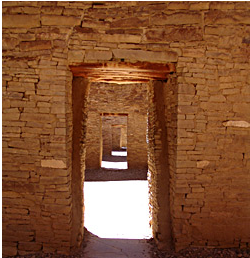Publication Date
7-1-2013
Abstract
This dissertation examines the issue of how migration and identity can be illuminated through the study of material culture. Specifically, this research focuses on the late Developmental to Coalition period transition (~AD 1050-1300) in the Albuquerque area and examines variation in ceramic technological and decorative style. This area was chosen because it is frequently portrayed as a frontier' or boundary between the Socorro District to the south and the Santa Fe District to the north. This perception is largely driven by changes in ceramic technology during this time period, which included a shift from a mineral-paint technology to carbon paint. The research tests four models of social change: (1)technofunctional model: a new technology was adopted by existing groups primarily for functional reasons; (2)social alliance model: social identities or alliances shifted from the south to the north ; (3)large-scale migration model: local people were displaced by northern migrants; and (4)small-scale migration model: small groups of northern migrants co-existed with local groups. Each model has different implications for change in ceramic technological and decorative style. Low-visibility attributes of pottery can be used to identify migration of people. While migrant potters may easily copy highly visible attributes of local pottery, typically, the way that potters manufacture a pot\u2014their 'learned' tradition\u2014 is resistant to change. Therefore, migrant pottery can be distinguished from local traditions through intensive research. Attributes reflective of the entire production process, and including chemical and mineralogical data to determine location of production, were collected and analyzed in order to evaluate these models. Results of analysis show differences between mineral-painted and carbon-painted vessels for all stages of pottery production\u2014 this variation encompasses decorative and technological traits as well as attributes reflective of the initial learning context. In addition, although there are temporal changes in these characteristics, the changes cross-cut temporal categories\u2014i.e., they differ even when time is controlled. Therefore, I argue that the results constitute clear evidence for production of mineral-painted and carbon-painted ceramics by different potters with different learned practices. Because there is no evidence for population replacement, the results are consistent with implications for model #4, small-scale migration. In addition, chemical compositional analysis show strong ties between the Albuquerque area and the Rio Puerco region to the west during both the late Developmental and Coalition periods. The data suggest that migrants (either individuals or small groups) arrived from the Rio Puerco region rather than from the Santa Fe area to the north. Data are inconclusive as to whether or not Albuquerque constitutes a frontier (defined by the movement of new groups into unoccupied areas) or a cultural boundary area. Based on available data, I argue that Albuquerque had a lengthy in situ occupation that was continuous, although populations were quite mobile. Frequent small-scale migration was also probably likely for all time periods, particularly from the Rio Puerco area. However, I agree with an argument made by Franklin and Murrell (2010) that the ancient inhabitants of Albuquerque should not be characterized as simply passive consumers of the products and cultural traditions of surrounding regions. Nevertheless, being situated along a boundary, or a 'cultural' frontier, it is likely that ceramic production was characterized by more open social learning networks, which may be why Albuquerque District ceramics do not fit well into established typologies. These data are also consistent with theoretical expectations for boundaries, where identities are more frequently renegotiated. This social flexibility may have been part of a long-term adaptive framework for Albuquerque populations. This research is broadly significant because it builds on existing models of the relationship between material culture and identity to more fully consider the visibility of an attribute in the context(s) of its production. Previous studies have focused largely on attribute visibility in the consumption or use of a ceramic vessel, while visibility of production processes has largely been overlooked. Ethno-archaeological work supports the idea that production processes that are more public are more likely to change as a result of changing interaction spheres or social identity; production contexts would have provided important opportunities for the communication of social messages to the local community, as well as reinforcing a feeling of social identity within and between potters themselves. The research has broader implications for anthropology because understanding how individuals use material culture to create, reinforce, or change their identity in relation to others is critical to understanding social behavior.'
Keywords
Archaeology, ceramics, migration, American Southwest, social identity, Albuquerque, Coalition Period
Project Sponsors
National Science Foundation, SRI Foundation, Hibben Trust, University of New Mexico,
Document Type
Dissertation
Language
English
Degree Name
Anthropology
Level of Degree
Doctoral
Department Name
Anthropology
First Committee Member (Chair)
Patricia L. Crown
Second Committee Member
James L. Boone
Third Committee Member
Richard Chapman
Fourth Committee Member
Joyce. M. Szabo
Recommended Citation
Larson, Dorothy L.. "Albuquerque the Frontier? Exploring Migration and Social Identity in the Albuquerque Area During the Late Developmental to Coalition Period Transition." (2013). https://digitalrepository.unm.edu/anth_etds/40

